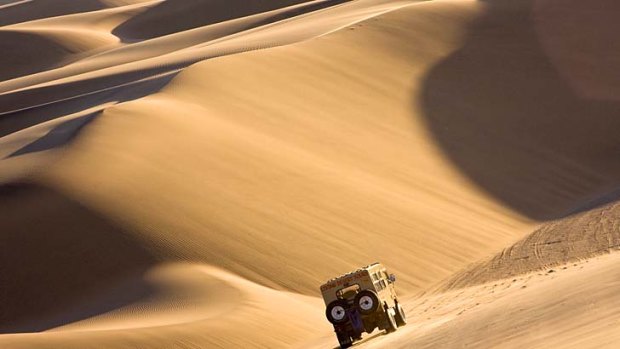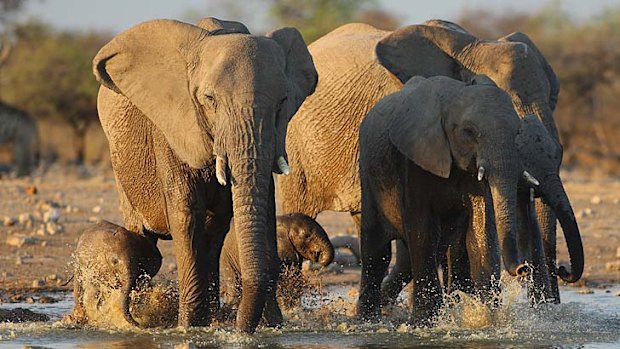
Way out of Africa ... sand dunes outside Swakopmund.Credit: Getty Images
Ben Groundwater says goodbye to bitumen for three weeks as he navigates African desert wilderness.
The GPS is blinking, indicating something ahead. "In 500 metres, turn right," it says. I scan the horizon, searching for the intersection. Nothing. "In 100 metres," the GPS voice says, "turn right." But there doesn't seem to be a road to the right. Just flat, featureless terrain - an endless stretch of dirt and rocks hemming the highway.
"In 20 metres, turn right." Still no road. "Turn right now."

Elephants at a waterhole at Etosha.Credit: AFP
And that's when the realisation dawns. There is no road. There never was. Just some rough tyre tracks. That's where we're going, too: a place with no cars, pedestrians, street signs and no more civilisation. And there won't be any for 10 days.
I make the right turn. Tyres crunch on the gravel. The view through the windscreen switches from white-lined bitumen to a blinding canvas of nothingness. The UHF radio under the passenger seat crackles into life. "Here we go!" someone in our convoy yells.
This is it. This is what we signed up for.
It's not a holiday, it's an adventure.
Namibia. Even on sealed roads, it's not exactly a busy place to drive in. The southern African nation is the size of NSW, with a population of 2 million. Many of the country's key highways are little more than gravel tracks carved in the desert floor.
I'm on a self-drive, four-wheel-drive safari through some of Namibia's least-visited lands, through towns that turn out to be little more than small groups of huts, down roads that don't really exist, past wild animals in natural habitats. We'll eat meals cooked on open fires and spend dark nights listening for the sounds of paws nearby.
Mike Boyd, whose company is running this three-week trip through desert and wilderness, has a favourite saying he keeps rolling out: "It's not a holiday, it's an adventure."
He's right. It's a serious adventure, tackling everything Namibia has to offer - from deeply corrugated desert paths to rocky valleys, grass plains and sandy riverbeds. It's a trip that will test our patience and skill, but also one that will take me to vast tracts of an almost untouched land.
We begin in the capital, Windhoek, where 11 travellers will drive in a convoy of four cars - Mike and his wife, Linda, leading the way in a classic Land Rover Defender (nickname "Bushpig"), the rest of us sharing the duties in three Nissan Navaras. All vehicles are kitted out for life off-road, with tents fixed to the roofs and long-range fuel tanks under the hoods.
Day one is all about packing and checking, getting last-minute supplies and going over the plan for the following few weeks. The next morning we hit the highway early, heading south. It's sealed for the first 10 kilometres, before we run into a dirt section. "Say goodbye to bitumen," Mike chuckles into the radio. "That's pretty much it for three weeks."
Already, the scenery is spectacular. Grass-covered hills morph into large rocky outcrops punctuated by acacia trees. There's a cry across the radio waves as someone spots a family of baboons perched in a tree. It's the first wildlife spotting but not the last; we see springbok, wildebeest and oryx in the first day as we drive to the town of Sesriem, the gateway to the dunes of Sossusvlei in the Namib-Naukluft National Park.
There's a buzz in the air as we make camp at night - even putting up a tent is exciting when it's the first time. Mike breaks out the gin and tonic, and we toast a successful journey, watching the sun gradually turn the long grass around us gold, then brown, before fading to black.
"KEEP the revs up!" Mike yells at me. "More speed! Foot flat to the floor!" My knuckles are turning white. "It IS flat to the floor."
"Well," Mike gasps, exasperated, "flatter!"
It's time for an impromptu four-wheel-driving lesson. For the places we're heading, you really need off-road experience and I have none. I don't know what a "diff lock" is. I've never engaged low-range gears. This is stuff that could be handy.
To remedy this, Mike has put me behind the wheel of the Land Rover and is coaxing me through the sandy desert floor in Sossusvlei. It is, frankly, a challenge. You have to keep the revs high to drive through soft sand, but as a rookie I'm fighting an instinct to take things slowly. And I don't want to be the first person to get a car bogged. I make it to solid ground, feeling slightly more confident about tackling the soft stuff we'll encounter in riverbeds up north.
The tour itinerary can be broken into three sections. The first takes in the giant dunes of Sossusvlei, in the country's south-west, and the adventure-sports capital of Swakopmund - places visited regularly by tourists. The second section is much more off the beaten track as we make that turn off the highway and head north from Swakopmund to the village of Puros, spending 10 days without seeing another car. The final section is spent in Namibia's famed Etosha National Park, enjoying small luxuries such as campsite swimming pools and tap beer in between wildlife viewing.
It's not a holiday, it's an adventure. That means we won't be having our hands held. Mike's not here as a tour guide, he says, but more as a facilitator. He'll offer all the help and advice he can, but the little things are up to us. If we want food cooked, we'll have to cook it. If we want our tents set up, we'll have to set them up. And if we want a tyre changed, we'll have to roll up our sleeves and change it.
There's a feeling the trip hasn't really started until the GPS sends us off-road well north of Swakopmund, making the right turn into barren desert. Almost immediately we're in Messum Crater, a collapsed volcano that feels about as far from civilisation as you can get. There's nothing here - just the sound of wind whistling over harsh terrain.
Now the driving gets tricky, with ascents of rocky tracks and large holes pockmarking the terrain. We spend the night in the shadow of the Brandberg Range and we're told to keep an eye out for desert elephants, which have been spotted marauding close by. We don't see any, but it's clear the danger posed by wildlife here is real. One campsite on our maps is marked "abandoned due to lions". Yikes. Our camp the next night has a sign warning of lions and elephants. We find paw prints the next day. Another morning everyone wakes convinced they had heard an elephant near the camp - going by the prints in the sand, however, it was a not-so-terrifying springbok. But we're on edge.
Despite the danger, there's also an incredible thrill, and the sightings of game become more frequent the further north we drive. First it's more springbok and oryx, before we start to spy flocks of ostrich hurtling past and herds of giraffe feeding on the high trees.
However, it's not until we reach Puros - a village of little more than mud huts on the Skeleton Coast near the Angolan border - that we stumble on the grand-daddy of them all, the desert elephant. Our cars are motoring down a riverbed when we spot a herd of six, the bull with its trunk deep in the sand, drinking the water below. There are ostriches nearby. A couple of oryxes. This is Africa, dangerous, beautiful Africa, right before our eyes.
These 10 days we spend exploring the country's north-west are amazing; tell-your-grandkids amazing. We meet Himba people, a tribe whose culture seems almost untouched by Western civilisation. The campsites we stay in are tiny and remote, adding to the feeling of adventure; the drive days are long and sometimes taxing, but always through impressive landscapes.
We drive among grassy plains, on rocky tracks and dirt until, eventually, we hit the black-top again, and our battered convoy of hardy adventurers pulls into camp at Etosha National Park, with its warm showers and cold beers. Those elements hardly seem necessary any more, however. We've just been on a real adventure - no tourists and no roads. That's what we signed up for.
Ben Groundwater travelled as a guest of Classic Safari Company.
BEEN THERE, DUNE THAT
Three more things to do
Sandboarding Some people see huge sand dunes and think of beauty; others see huge dunes and think ski slope. For the latter, Ultimate Sandboarding (ultimatesandboarding.com) runs daily trips to dunes. Wear old clothes.
Quad biking At Walvis Bay, about 30 kilometres south of Swakopmund, adrenalin and education mix at Fanie du Preez's Kuiseb Delta Adventure tours. Four-hour trips include sand duning, visit to an ancient midden and a meeting with the local Topnaar people, who live among the dunes. See kuisebonline.com.
Eating Swakopmund is the last place you'll encounter restaurants on this trip, so it's worth indulging in a few meals out. Watch the sun set over the ocean at the Tiger Reef Beach Bar with a beer, before tucking into a huge serve of the bar's fish and chips.
FAST FACTS
Getting there
Qantas has a fare to Windhoek for about $2974 low-season return from Sydney, including taxes. Fly to Perth (about 4hr), then to Johannesburg (11hr codeshare with South African Airways), then to Windhoek (2hr). See qantas.com.au.
Touring there
A self-drive 13-day Namibia Safari starts from $6000 a person; a 20-day Namibia Safari from $8500 a person; a 20-day Namibia and Botswana Safari from $9500. All prices include specified accommodation and meals, camping-equipped four-wheel-drive vehicles, fuel, an escort and support. See selfdrivesafaris.com.au, email info@selfdrivesafaris.com.au.
More information
Sign up for the Traveller Deals newsletter
Get exclusive travel deals delivered straight to your inbox. Sign up now.